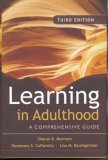Learning in Adulthood
By Murray Bourne, 19 Sep 2007
A Comprehensive Guide
by Merriam, S., Caffarella, R. and Baumgartner, L.

Do adults learn differently than children? If so, how?
Learning in Adulthood offers many insights into the different ways that adults think, learn, remember and view the world, compared to children.
Starting from the work of Knowles in the 1960s, the study of adult education has become more extensive, especially as the amounts of money being spent by adults on formal education has grown exponentially. No surprise there − there are a growing number of older people for whom education will become more important as they approach, and embrace retirement age.
How will adult education develop over the next 20 years? How should it be designed to maximise adult learning outcomes (bang for the buck)?
The book includes a thoughtful critique on Knowles' views on adult learning. Knowles called his theories "andragogy" (or the study of adult learning, as opposed to "pedagogy", the study of learning in children). He wrote that adult learners are self-directed, prior experience is a valuable base for new learning, adult learning is related to social roles and that adults need to see immediate application for the learning.
Some of the criticisms leveled at Knowles' view include that it assumes that learning is only self-directed (what is the role of the instructor?), that it is too male- and White-oriented (as is a lot of educational theory) and that not there is not enough recognition of the role of context in learning.
My own criticism of Knowles' theory is that I don't believe there is that much difference between adults and teenagers when it comes to the desire to know the application for a particular learning event. One of the most common questions I ever heard from secondary students was "when are we ever gonna use this stuff?".
Cultural Context
For the updated (3rd) edition, the authors added a chapter on "non-Western perspectives" of adult learning, where they describe how Islamic, Maori (of New Zealand), Confucian, Hindu and African Zulu cultures view learning in adulthood.
Being a White male with a Western educational background who has taught in Asia now for 14 years, I found this chapter to be particularly interesting.
One thing that is striking (not new, but good to think more about) is the Asian notion of interdependence and how a lot of what we do in education is to try to bring about dependence of thought and action. Similarly, educational approaches like constructivism (students create their own knowledge and understanding from a given learning experience) are somewhat at odds with a Confucian model of education (the teacher is the guru, teacher teaches, student learns, student does examination, student passes).
Other Themes in the Book
I found the following topics quite interesting:
- Embodied learning. Descartes was the philosopher who gave us "I [that is, my mind, by which I am what I am] is entirely and truly distinct from my body." (He also gave us a lot of mathematics, like the Cartesian plane). We now believe the mind-body connection is not so separate when it comes to learning.
- Spiritual learning, which means more that just religion.
- Is intelligence affected by aging? (what is intelligence anyway...?)
- Is memory affected by aging? (or is it just the processing and retrieval of memory...?)
Conclusion
Learning in Adulthood is certainly a "comprehensive guide", with its 440 pages of text and 65 pages of references.
It is an interesting read, especially for those of us who are involved in training of adults. More than that, we all need to ponder our own learning. After all, life expectancies are increasing and many people will find themselves living 20 to 40 years beyond their working lives, with "nothing to do". Learning will certainly be an important part of their time. Learning in Adulthood gives a good overview on how we can view our own learning as adults.
Be the first to comment below.
